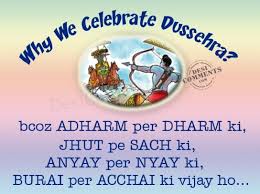Victory of Prabhu Ramachandra over Ravana :-
On this day in the Treta Yug, Rama, also called Shri Ram, the seventh incarnation of Vishnu, killed the great demon Ravana who had abducted Rama's wife Sita to his kingdom of Lanka. Rama, his brotherLakshman, their follower Hanuman and an army of monkeys fought a great battle to rescue Sita. The entire narrative is recorded in the epic Ramayana, a Hindu scripture.
Rama had performed "Chandi Homa" and invoked the blessings of Durga, who blessed Rama with secret knowledge of the way to kill Ravana. On the day of Ashvin Shukla Dashami, Rama's party found Sita and defeated Ravana. Based on the inferences from Balmik’s Ramayana, Kalidas’s Raghuvans, Tulsidas’s Ram Charit manas, and Keshavdas’s Ram Chandra Yas Chandrika as well as common perception in North India, Ram, Sita, and Lakshman returned to Ayodhya 0n the 14th day of the month of Kartik (19-20 days after Vijay Dashmi). To mark the return of Lord Ram, in the evening, the residents of Ayodhya lighted their city with millions of earthen lamps (called Deepak). Since then, this day is celebrated in north India as Deepawali or Diwali.
During the ten days of Dasha-Hara, Deities of Ravana, his brother Kumbhakarna and son Meghanad are erected and burnt by enthusiastic youths at sunset.
After Dasha-Hara, the hot summer ends, especially in North India. The coming cold weather is believed to encourage infections. The burning of the effigies, filled with firecrackers containing phosphorous, supposedly purifies the atmosphere, while the temples perform Chandi Homa or Durga Homa, with the same intent.
Many people perform Aditya Homa as a Shanti Yagna and recite Sundara Kanda of Srimad Ramayana for nine days. These Yagna performances are thought to create powerful agents in the atmosphere surrounding the house that will keep the household environment clean and healthy. These rituals are intended to rid the household of the ten bad qualities, which are represented by ten heads of Ravana as follows:
- (1) Kama vasana (Lust)
- (2) Krodha (Anger)
- (3) Moha (delusion)
- (4) Lobha (Greed)
- (5) Mada (Over Pride)
- (6) Matsara (Jealousy)
- (7) Manas (Mind)
- (8) Buddhi (Intellect)
- (9) Chitta (will)
- (10) Ahankara (Ego).
HAPPY DUSSEHRA TO ALL OF YOU FROM ME...............
DEEPAK

No comments:
Post a Comment